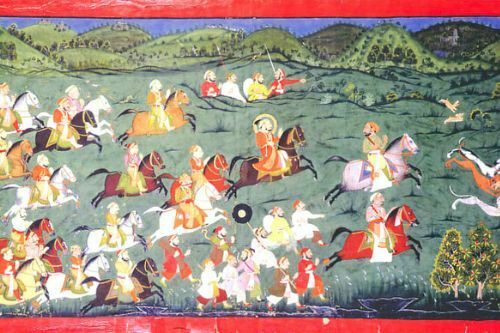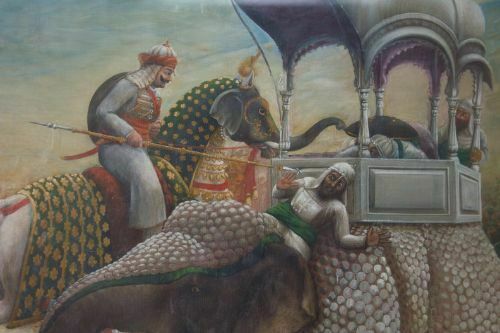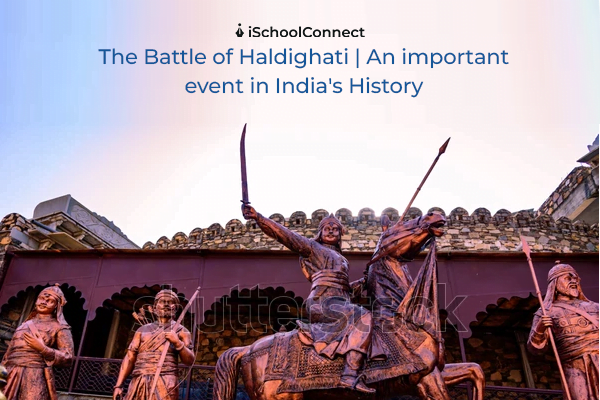Table of Contents
- When did the battle of Haldighati take place?
- The reason behind the battle of Haldighati
- The initial stage of the battle of Haldighati
- The ongoing battle between Maharana Pratap and Man Singh
- The unexpected turn of events on the battlefield of Haldighati
- Who won the battle of Haldighati?
- After the battle of Haldighati
- Key takeaways
- FAQs
Rajasthan is known as one of the most beautiful states in India. The rich food and culture in the state are the main attractions for tourists around the world. Colorful clothes and ornaments are widely available in the state of Rajasthan. Apart from this, Rajasthan is known for its lionhearted ruler, Maharana Pratap. He was the reason behind the fearless Rajputs and the battle of Haldighati
When did the battle of Haldighati take place?
The epic battle of Haldighati took place on the 18th of June 1576. The war took place between the extraordinary Rajput leader Maharana Pratap and Man Singh, who was at the time the general of the Mughal empire led by Akbar. It is known as the shortest battle ever fought in the history of battles because it lasted only four hours!
The reason behind the battle of Haldighati

Akbar had already conquered Delhi and Punjab and had taken Jaunpur and Bundelkhand from the Marathas. He wanted to conquer the kingdom of Mewar, which was ruled by the Rana family. Akbar offered the Rana a choice: either he could become an ally of the Mughals, or else face war. He tried to convince Maharana Pratap to join his empire. Akbar sent ambassadors to the Rana of Mewar and asked him to become his vassal.
The first embassy was Jalal Khan, whose efforts failed to persuade Maharana Pratap. Later, Akbar sent Man Singh. Although Maharana Pratap warmly welcomed him, Man Singh could not convince Rana Pratap.
Akbar then dispatched Raja Bhagwant Das, who outperformed his predecessors. Rana Pratap was persuaded enough to put on a robe sent by Akbar and send his young son, Amar Singh, to the Mughal court. Akbar found this unsatisfactory and demanded that Rana surrender to the Mughal court.
The final emissary, Todar Mal, was sent to Mewar who also returned unsuccessfully. These futile attempts enraged Akbar, and this was the driving force behind the battle of Haldighati.
The initial stage of the battle of Haldighati
Rana Pratap had desired to choose a location where his small army could fight the Mughal army with some strategic advantage. He chose the Haldighati pass because it had hills and mountains, also a lot of bushes and trees to provide the necessary cover. The Haldighati pass also provided an easy escape route for Maharana Pratap’s small army in the event of defeat.
The battle was held in Haldighati, a mountain pass in Rajasthan’s Aravalli Range in western India. The Mughal leader, Raja Man Singh of Amber, was supposed to command an army of 5,000 men.
The ongoing battle between Maharana Pratap and Man Singh
Rana Pratap’s army, on the other hand, included about 3,000 cavalry and 400 Bhil archers led by Punja, the tribal chief of Mirpur. Both sides had war elephants for the battle, though the Rajputs did not carry firearms.
The fact that Maharana Pratap had fewer means and other resources such as weapons and armor and very few allies, convinced Akbar that his victory was unassailable. Akbar was unaware of the strength, boldness, and fortitude of the small army of Bhils, Tanwars of Gwalior, and Rathores of Merta.
The war continued non-stop for four hours, and soldiers from both sides fought courageously till their last breath. There was bloodshed and a huge loss of lives. Maharana Pratap was badly injured during the war, but he still insisted on fighting with his brave and loyal horse, Chetak.
The unexpected turn of events on the battlefield of Haldighati

As the battle seemed nearly impossible to fight, due to the overpowering of the Mughals, Maharana needed to get out of the hopeless situation so that he could fight another day. But he insisted on staying on the battlefield, as his nobles persuaded him otherwise.
Man Singh Jhala, the general commander of Maharana Pratap’s army, then devised a strategy, and an event occurred that would be difficult to replicate. Man Singh Jhala seized the royal umbrella from his grasp and began impersonating Maharana; before the enemy realized what had happened, he had drawn the full force of the Mughal attack towards himself.
His sacrifice and that of 350 other soldiers who fought back, helped Maharana Pratap escape from the battleground.
Shakta saved his brother Rana Pratap while escaping from the battle of Haldighati. When Chetak collapsed, Shakta offered his horse to Maharana Pratap for his safe return.
The Mughal army was astonished to find out that the one they killed was not Maharana Pratap, but his general.
When Man Singh returned the next morning to attack the Mewar army, there was no one on the battlefield.
Who won the battle of Haldighati?
To this day, it is still not confirmed who won the battle of Haldighati.
The Mughals may have won the battle, but they could not capture Mahara Pratap.
For the Rajputs, it was a tragic and unfortunate loss.
The ultimate glimpse of bravery and loyalty was shown by Rana Pratap’s horse, Chetak. He helped Rana escape safely and reach the hills.
The battle of Haldighati was significant because of the bravery shown by the Rajputs and the small tribe of Bhils. There was bloodshed. The Rajputs fought head-on with the Mughal army. The battlefield felt a strong presence of will, anger, helplessness, and despair. Rana Pratap demonstrated courage and bravery during the Haldighati battle and acted as the strength to all the Rajputs fighting tirelessly for their motherland!
It was also a pivotal event for the Mughals. The Mughals were desperate to win the battle and rule over the Rajputs. Akbar wanted this win to take over Mewar and get a step ahead in order to capture other states. It was a fierce battle, with both sides displaying strong willpower. The outcome was inconclusive. The Rajputs left no stone unturned to defeat the Mughals in the war! Even today, the battle is regarded as a valid symbol of the Rajputs’ courage, sacrifice, and loyalty in saving their motherland.
After the battle of Haldighati
It is said that after the battle of Haldighati, Rana Pratap continued to attack the Mughals using guerrilla warfare techniques. Rana Pratap stayed in the hills and tormented the large Mughal forces in their camps. He ensured that Mughal troops in Mewar never lived in peace. Akbar launched three more expeditions to drive Rana Pratap out of his mountain hideouts, but they all failed. The Bhils assisted Rana Pratap by sharing their knowledge and ways of living in the woods.
Key takeaways
- The battle of Haldighati took place on the 18th of June 1576, and the intense battle lasted for four hours.
- Man Singh Jhala sacrificed his life to ensure Maharana Pratap lived and won the war against the Mughals.
- Maharana Pratap’s brave and loyal horse, Chetak, was the real hero during the battle of Haldighati.
Did you find the blog informative? If so, please share your views in the comments below. Click here to reach out to us for more information on the battle of Haldighati. We would be happy to assist you with your queries!
Liked this blog? Read next: History | Incredible facts about the subject you must learn!
FAQs
Q1. Where is Haldighati on the India map?
Answer – Haldighati is a mountain pass between Khamnore and Balicha village in Rajasthan, western India, connecting the districts of Rajsamand and Udaipur.
Q2. Who is the writer of the book Haldighati?
Answer – Shyam Narayan Pandey is the author of the book Haldighati, written in Hindi.
Q3. How did Haldighati get its name?
Answer- Haldighati is a well-known mountain pass in the Aravalli Hills. The pass connects the districts of Rajsamand and Pali and is about 40 kilometers from Udaipur. The pass gets its name from the region’s yellow soil (turmeric is called Haldi in Hindi).






